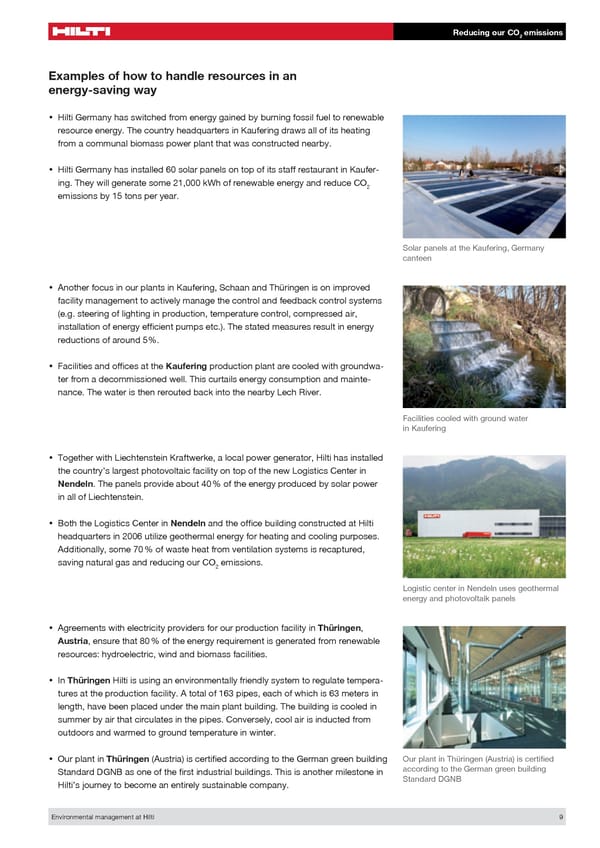Reducing our CO emissions 2 Examples of how to handle resources in an energy-saving way • Hilti Germany has switched from energy gained by burning fossil fuel to renewable resource energy. The country headquarters in Kaufering draws all of its heating from a communal biomass power plant that was constructed nearby. • Hilti Germany has installed 60 solar panels on top of its staff restaurant in Kaufer- ing. They will generate some 21,000 kWh of renewable energy and reduce CO2 emissions by 15 tons per year. Solar panels at the Kaufering, Germany canteen • Another focus in our plants in Kaufering, Schaan and Thüringen is on improved facility management to actively manage the control and feedback control systems (e.g. steering of lighting in production, temperature control, compressed air, installation of energy efficient pumps etc.). The stated measures result in energy reductions of around 5%. • Facilities and offices at the Kaufering production plant are cooled with groundwa- ter from a decommissioned well. This curtails energy consumption and mainte- nance. The water is then rerouted back into the nearby Lech River. Facilities cooled with ground water in Kaufering • Together with Liechtenstein Kraftwerke, a local power generator, Hilti has installed the country’s largest photovoltaic facility on top of the new Logistics Center in Nendeln. The panels provide about 40% of the energy produced by solar power in all of Liechtenstein. • Both the Logistics Center in Nendeln and the office building constructed at Hilti headquarters in 2006 utilize geothermal energy for heating and cooling purposes. Additionally, some 70% of waste heat from ventilation systems is recaptured, saving natural gas and reducing our CO emissions. 2 Logistic center in Nendeln uses geothermal energy and photovoltaik panels • Agreements with electricity providers for our production facility in Thüringen, Austria, ensure that 80% of the energy requirement is generated from renewable resources: hydroelectric, wind and biomass facilities. • In Thüringen Hilti is using an environmentally friendly system to regulate tempera- tures at the production facility. A total of 163 pipes, each of which is 63 meters in length, have been placed under the main plant building. The building is cooled in summer by air that circulates in the pipes. Conversely, cool air is inducted from outdoors and warmed to ground temperature in winter. • Our plant in Thüringen (Austria) is certified according to the German green building Our plant in Thüringen (Austria) is certi昀椀ed Standard DGNB as one of the first industrial buildings. This is another milestone in according to the German green building Hilti’s journey to become an entirely sustainable company. Standard DGNB Environmental management at Hilti 9
 Environmental Management at Hilti Page 8 Page 10
Environmental Management at Hilti Page 8 Page 10